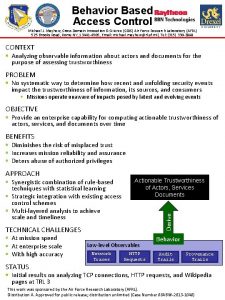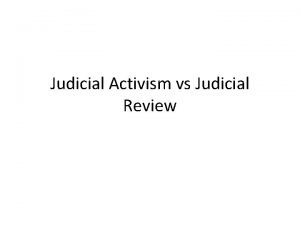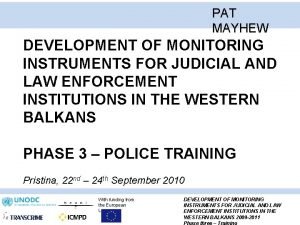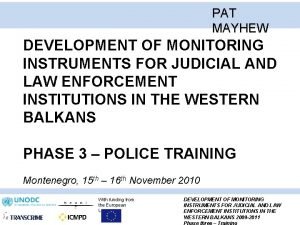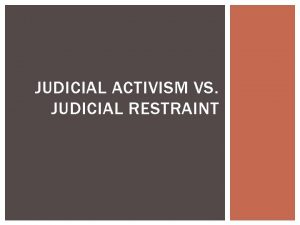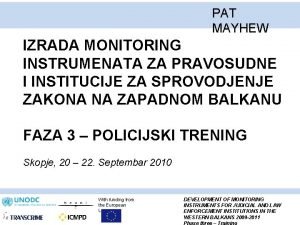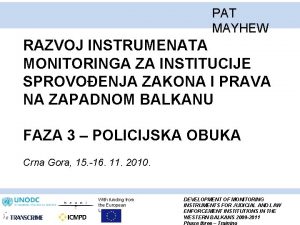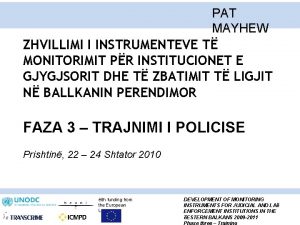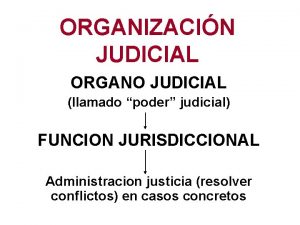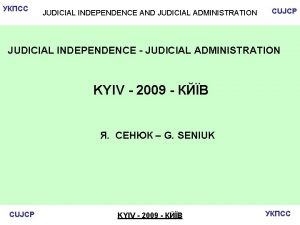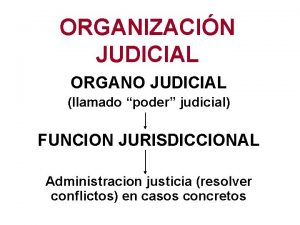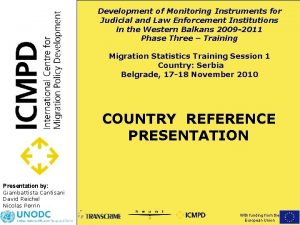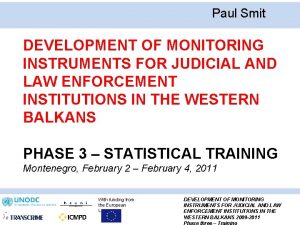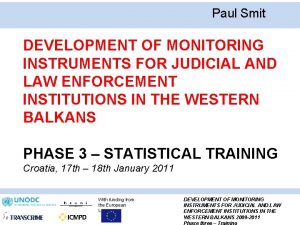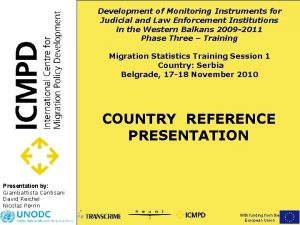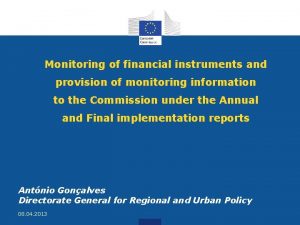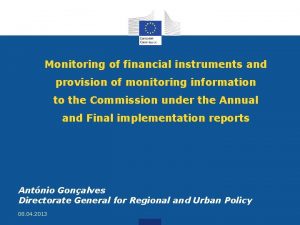PAT MAYHEW DEVELOPMENT OF MONITORING INSTRUMENTS FOR JUDICIAL





















































![WHAT NEEDS MORE ATTENTION [Points from previous sessions] OPEN DISCUSSION WHAT NEEDS MORE ATTENTION [Points from previous sessions] OPEN DISCUSSION](https://slidetodoc.com/presentation_image_h2/454d80044553fc7446abc6bbac288fd3/image-54.jpg)



- Slides: 57

PAT MAYHEW DEVELOPMENT OF MONITORING INSTRUMENTS FOR JUDICIAL AND LAW ENFORCEMENT INSTITUTIONS IN THE WESTERN BALKANS PHASE 3 – POLICE TRAINING Skopje, 20 th – 22 nd September 2010 With funding from the European Union DEVELOPMENT OF MONITORING INSTRUMENTS FOR JUDICIAL AND LAW ENFORCEMENT INSTITUTIONS IN THE WESTERN BALKANS 2009 -2011

SESSION 1 • Introductions • Where this training fits into the CARDS Project • How the sessions are organised

MY BACKGROUND • Now retired – freelance consultant • Previously Director of Crime and Justice Research Centre, Victoria University of Wellington, New Zealand • Consultant Criminologist, Autralian Institute of Criminology • Research Fellow, National Intitute of Justice, USA • Most of career – Home Office Research, Development and Statistics Directorate § Managing and doing research § Ran the British Crime Survey § Responsible for statistics on police-recorded crime § And other police figures - e. g. detections, arrests, police manpower

INTRODUCTIONS FROM PARTICIPANTS

STRENGTHENING JUSTICE & HOME AFFAIRS STATISTICS IN THE WESTERN BALKANS • Objective: to strengthen response to crime and corruption by bringing national statistics justice and home affairs towards compliance with international standards and EU acquis • Project funded by the EU under the CARDS programme with additional funds from Germany • Started in 2009, ends in 2011 • Three phases 7 countries / territories Albania, Bosnia & Herzegovina, Croatia, FYROM, Kosovo (under UNSCR 1244), Montenegro, Serbia

THE THREE PHASES: PHASE 1 (RESEARCH) • Set out relevant international standards and EU acquis • Picture of the strengths & weaknesses of data collection systems • Identify gaps and needs of statistical systems It involved: Ø Desktop research Ø 7 research missions One output: Ø Technical Assessment Reports for 7 countries / territories

PHASE 2: GUIDELINES • To identify common data collection challenges • To discuss and adopt specific draft programme guidelines • To agree a set of regional indicators • To prioritise training needs and adopt outlines of training programmes It involved: Ø Preparation of draft Programme Guidelines Ø Feedback from project countries / territories Ø Discussion and adoption at First Regional Workshop One output: Ø Programme Guidelines adopted

PHASE 3: TRAINING • To design and deliver targeted training activities • To improve national capacities to record and report JHA statistics in line with international standards and EU acquis • To identify areas for further work and improvements It involves: Ø Training to be carried out by international experts together with national focal points and national counterparts Ø Training delivered to police, prosecution, courts, and institutions in areas of migration / asylum / visa

FIRST REGIONAL WORKSHOP (SKOPJE, MAY 2010) Goals • To present the technical assessment reports • To identify common data collection challenges • To adopt specific draft guidelines • To prioritise training needs • To adopt the outlines of the training program • To agree on a set of regional indicators

CHALLENGES OF THE CCJ STATISTICAL SYSTEM IN THE WESTERN BALKANS • Developing person-based systems • Developing better computerised systems to record data • Assigning a unique Integrated File Number (IFN) to personrecords in order to track persons across the whole CCJ system • Defining clear written counting rules to record crime incidents • Training all responsible staff with regard to implementation • Enhancing statistical analysis of the data collected • Improving public dissemination of the data collected I WILL DEAL WITH SOME BUT NOT ALL OF THESE ISSUES

RECOMMENDATIONS FROM THE PROGRAMME GUIDELINES #1 Offender-victim relationship and - if available - ethnicity Session 4 # 3, # 4 Dealing with cases where there are multiple Session 4 offences and suspects (# 3). ‘principle offence rule’ (# 3). Training for others on this (# 4) # 6, # 7 Publication of annual standard tables on offences, offenders and victims. Internet publication. Sessions 3, 5, 6 # 46 Victim surveys Session 7

SESSION 2: OVERVIEW OF REPORTS OF POLICE DATA AT INTERNATIONAL & NATIONAL LEVEL • The need for valid data and common standards – some preaching! • Main international compilations of police figures • Two examples of national reports Ø England & Wales Ø New Zealand • Introduction to suggested Regional Indicators and Pilot Data Collection Exercise

THE NEED FOR VALID STATISTICS • For knowledge-based crime policy. . You need to know ‘the facts’ • To interpret your knowledge. . You need to compare across years, and across countries • To compare. . Your data need to be comparable within your own jurisdiction over time, and – ideally – with other jurisdictions • To be comparable. . Means that common standards have been applied – within the jurisdiction, and over time, and – ideally – the same as other jurisdictions Based on Kauko Aromaa (HEUNI)

COMMON STANDARDS • Work developing fast within the UN and the EU Ø Guidance manuals from the UN and EU (massive!) • But there are considerable difficulties in reaching comparability because of: Ø Different legal frameworks and definitions of offences Ø Different policing and prosecutorial arrangements Ø Differing capacities in criminal justice agencies Ø Different operational requirements that the statistics serve Ø Different counting rules (Session 4)

INTERNATIONAL REPORTS • Not very long-standing • All come with substantial caveats • World Health Organisation – covers violence (probably least comparable) • United Nations Survey on Crime Trends and the Operation of the Criminal Justice System (UN – CTS) • European Sourcebook • Eurostat: Statistics in Focus – Crime and Criminal Justice

UNITED NATIONS • Latest edition 2010 (covering data from 1996 – 2006) • Data available • Macedonia provided data for 9 th and 10 th Survey (not 11 th) • Covers more than police-recorded crime - e. g. , CJS personnel and prisoner numbers • Data requirements have been simplified over time http: //www. unodc. org/documents/data-and-analysis/Crimestatistics/International_Statistics_on_Crime_and_Justice. pdf

EUROPEAN SOURCEBOOK • Latest edition 2010 • About three previous editions • Data available • Macedonia has not provided data • Much work done on improving and documenting comparability http: //www. europeansourcebook. org/ob 285_full. pdf

EUROSTAT • Latest edition 2009 • Modelled on Sourcebook • Macedonia has provided data • Seven crime types • Limited commentary, but good notes http: //epp. eurostat. ec. europa. eu/cache/ITY_OFFPUB/KS-SF-09 -036/EN/KS-SF 09 -036 -EN. PDF

NATIONAL REPORTS • Massive variety of styles • Usually annual • Sometimes with other criminal justice system information; sometimes not • Sometimes with special topics; sometimes not • USA – ‘Index’ crimes only • Now usually available on the web • Data sometimes downloadable

ENGLAND & WALES • Publication has changed over time • Now covers British Crime Survey (BCS) and police figures • Produce additional reports - e. g. , homicide • Also quarterly bulletins • Publication tightly controlled by Office of National Statistics rules

ENGLAND & WALES (2) Latest publication covers: Ø Extent of and trends in crime Ø Violent and sexual crimes Ø Acquisitive and other property crime Ø Publications perceptions Ø Detection of crime Ø Geographic patterns of crime Most chapters draw on police figures and British Crime Survey Discontinuance in police figures Ø Major changes in offence coverage in 1998 § e. g. , minor assaults Ø Also changes in police recording practices § e. g. , counting by victims

NEW ZEALAND GOOD POINTS • Straightforward • Show detection (resolution) figures • Monthly online figures BAD POINTS • Both fiscal and calendar year publications – too much • Little commentary (need to read Police Annual Report as well) • Nothing about victims • Nothing about offenders

NEW ZEALAND (2) • Review of statistics in 2009 (last review in 1982) – • e. g. recommendation to record victim-offender relationship Another discontinuance in the figures Ø Major change in computer systems § New system meant fewer offences were ‘lost’ Ø New police recording rules § Bought some area more into line with the areas with the most ‘generous’ recording

SUGGESTED REGIONAL INDICATORS (1) No. of CRIMES recorded by the police, by offence type Recorded by the police (some crimes are not reported by victims) No. of PERSONS recorded by the police as suspects, by offence type The first stage of the ‘attrition’ calculation. In the current system, these are ‘suspects’. No. of PERSONS (suspects), by age group No. of PERSONS (suspects), by sex No. of PERSONS (suspects), by citizenship No. of PERSONS (suspects), by ethnicity No. of PERSONS (suspects), by whether recidivist or not Not currently collected Feasible?

SUGGESTED REGIONAL INDICATORS (2) No. of VICTIMS of crime recorded, by offence type No. of VICTIMS recorded, by age Issue of counting the number of victims No. of VICTIMS recorded, by sex No. of VICTIMS recorded, by citizenship No. of VICTIMS recorded, by ethnicity Offender-victim relationship in recorded crime, by offence type May be problematic for some crime types

SUGGESTED REGIONAL INDICATORS (3) Victimisation rates (prevalence rates) by crime type according to victim surveys Crimes included in scope of the survey Share of crimes reported an unreported according to victim surveys Crimes ‘reported to’ the police, or which ‘the police came to know about’

OFFENCES FOR THE REGIONAL INDICATORS The following offence types are considered as core crimes to be covered in the 12 th UN Survey by the end of 2010: Intentional Homicide Violent Crime Assault Sexual Violence Rape Robbery Not all these offences are being covered in the Pilot Data Collection Exercise Property Crime Theft Motor Vehicle Theft Burglary Domestic Burglary/Housebreaking Drug Possession/Use Drug Trafficking Kidnapping for Ransom

SESSION 3: TABLES AND ANALYSIS IN MACEDONIA POLICE REPORTS • What tables cause most problems? • How could these problems be best solved? • What tables are most needed, used, and liked? • Are there tables not used or liked? • How do the tables meet the requirements of the suggested Regional Indicators and the Pilot Data Collection Exercise?

SESSION 4: PARTICULAR ISSUED FROM THE RECOMMENDATIONS • The Principle Offence Rule (Recommendation 3) • Multiple offences and suspects (Recommendation 3) • Training implications • Victim-offender relationships (Recommendation 1) • Ethnicity of offenders and victims (Recommendation 1)

COUNTING RULES IN POLICE STATISTICS “…. the rules applied in each country to count offences included in crime statistics. Such rules vary … hence introducing differences in recorded crime rates that do not reflect actual differences in the levels of crime”. Aebi 2003, p. 1. What we know is that there are NO CONSISTENT counting rules across the Western Balkans, or across other countries However, there is ‘best practice’ guidance

THE PRINCIPLE OFFENCE RULE (POR) International guidelines suggest it may be appropriate to apply a POR when counting and reporting offences. Written counting rules should say whether a POR rule is applied or not • In the Western Balkand, only Albania applies a POR • In other Western countries, about half apply a POR, and half do not • The main thing is to know (if there is no POR, the crime count is higher) Ideally, the POR should be consistent across agencies – police, prosecutors, courts • BUT changing to a POR will reduce the crime count, and cause a ‘break’ in the crime statistics series

THE PRINCIPLE OFFENCE RULE - EXAMPLE Assault Criminal damage Offences Suspects Offences POR No POR 1 2

MULTIPLE OFFENDERS / SUSPECTS If there is more than one offender involved in an offence, six of the Western Balkans countries count one offence (including Macedonia) In one country, the number of offences = the number of offenders In terms of suspects, it is reasonable to count two Assault Criminal damage Offenders (suspects) No POR One Two Offences 2 2? Suspects 1 2

MULTIPLE OFFENCES What happens when a victim reports more than one offence at the same time? For example, different incidents of domestic violence. . . • In all the Western Balkans, the rules are that all offences are counted, with the exception of Albania The important thing is for the rules to be understood and consistently applied

TRAINING IMPLICATIONS Ø Are the various counting rules well understood? Ø Are they consistently applied? Ø Where do problems arise? Ø How do the rules fit in with what prosecutors and the courts count?

VICTIM-OFFENDER RELATIONSHIPS The primary interest is in: • People known to each other >>> not known to each other Ø Important for ‘stranger violence’ • People who are (or were) partners (‘partner violence’) Ø Violence by ex-partners seen as important as violence by current partners • People who are in a domestic relationship ranging wider than partners (‘domestic violence’) There are several possible classifications

VICTIM-OFFENDER RELATIONSHIPS (2) INTERNATIONAL CRIME VICTIMISATION SURVEY 1 SPOUSE, PARTNER (AT THE TIME) 2 EX-SPOUSE, EX-PARTNER (AT THE TIME) 3 BOYFRIEND (AT THE TIME) 4 EX-BOYFRIEND (AT THE TIME) 5 RELATIVE 6 CLOSE FRIEND 7 SOMEONE HE/SHE WORKS/WORKED WITH 8 NONE OF THESE 9 REFUSES TO SAY

VICTIM-OFFENDER RELATIONSHIPS (3) UN MANUAL FOR THE DEVELOPMENT OF A SYSTEM OF CRRIMINAL JUSTICE STATISTICS (pp. 55 AND 60) Spouse Ex-spouse Parent Child Other family Friend Business relation Acquaintance Stranger Other Issue of ‘partners’ Issue of step-parents What is a ‘child’ How extended is the ‘family’ Boy-friend / girl-friend? Seen before but don’t know? The issue is whether known or not

ETHNICITY Used for example for ‘Reported Adult Perpetrators’ Macedonian Albanian Turks Vlachs Serbs Bosniacs Other (1%) Unknown (3%)

OFFENCES RELEVANT FOR THE PILOT DATA COLLECTION EXERCISE 1. All offences 2. Completed Intentional Homicide 3. Violent Crime Assault Sexual Violence Rape Robbery • Drug Trafficking • Drug Possession/Use • Migrants Smuggling • Trafficking in persons • Total corruption offences Passive Bribery

INFORMATION TO BE COLLECTED IN THE PILOT DATA COLLECTION EXERCISE 1. Number of offences recorded by the police, by offence type 2. Number of persons recorded by the police as suspects, by offence type 3. Profile of persons recorded by the police as suspects, by offence type and Sex Age Citizenship Ethnicity Recidivism 4. Victim-offender relationship, by offence type 5. Profile of victims recorded by the police, by offence type and Sex Age Citizenship Ethnicity

SESSION 6: PUBLICATION OF RESULTS, ANALYSIS AND INTERPRETATION Ø What types of publication are feasible? Ø What frequency of publication is feasible? Ø Matching different user requirements Ø What types of analysis are best? What are feasible? Ø The type and amount of analysis and interpretation

SESSION 7: VICTIMISATION SURVEYS • The purposes of victimisation surveys • Strengths and weaknesses • Three international comparative exercises Ø International Crime Victimisation Survey (ICVS) Ø ICVS-11 Ø Eurostat survey in 2013 Ø Western Balkans Corruption Survey

VICTIMISATION SURVEYS (1) • Developed since 1970 s (USA, Netherlands, Scandinavia) • Many countries now have their own ‘bespoke’ surveys Ø which have run for many years Ø providing an independent measure of trends in crime • These bespoke surveys are not very comparable e. g. , Differences in offence coverage Counting rules! • Some international surveys (later)

VICTIMISATION SURVEYS (2) • Focus on individuals and their direct experience of crime Ø Whether or nor reported to the police Ø Thus providing an independent measure of crime • Good for describing the nature of everyday experience of victimisation • Can show which types of people are most at risk (by collecting sociodemographic information • Use sample survey methodology – mainly to get representative samples • Household surveys most common, but there also Ø Surveys of businesses • Generally take up other crime-related topics – e. g. , fear of crime, security precautions, attitudes to the police

VICTIMISATION SURVEYS (3) • Sometimes focus on particular groups e. g. , women, ethnic minorities • Sometimes focus on particular types of crime e. g. , domestic violence, sexual victimisation • Usually measure victimisation over the last year (but sometimes longer) • Many countries have their own ‘bespoke’ surveys Ø Which have run for many years – providing independent measure of trends in crime • These bespoke surveys are not very comparable e. g. , Differences in offence coverage Counting rules!

VICTIMISATION SURVEYS (LIMITATIONS) • Can’t cover all crimes Ø murder (obviously) Ø Fraud Ø victimisation of children difficult • Non-response can be high Ø Are non-responders different? • Do respondents remember everything? Minor offences likely to be forgotten • Do respondents tell interviewers everything? (Domestic violence) • Sampling error Ø Problematic for more uncommon crimes (e. g. , robbery)

VICTIMISATION SURVEYS (METHODS) • Face-to-face interviews were ‘gold standard’ – but expensive • Computer technology - made a big difference Ø CAPI – Computer Assisted Personal Interviewing Ø CATI – Computer Assisted Telephone Interviewing § Cheap, but limits interview length § Increasing mobile phone ownership posing a problem Ø CASI – Computer Assisted Self Interviewing § Good for sensitive subjects • Postal questionnaires uncommon Ø Cheap but poor response • Internet surveys in development – Computer Assister Web Interviewing (CAWI) Ø But will need lots of testing

INTERNATIONAL VICTIMISATION SURVEYS • Set up because independent surveys not comparable Ø Meant to use identical questionnaires Ø Same analysis methods • A few international business surveys • Some international surveys on violence against women Ø but some lack of comparability – e. g. WHO

THE MAIN ONES International Crime Victimisation Survey (ICVS) Five sweeps - 1989, 1992, 1996, 2000, 2004/5 Tirana (Albania) ‘ 96; Zagreb (Croatia) ‘ 96, 2000; Skopje ’ 86 Belgrade (Yugosl. ) ‘ 96 2004/5 ICVS – two different threads EU-ICVS 15 member states ICVS outside EU 15 countries All told, 30 countries + 33 city surveys None of the Western Balkan countries ICVS-II – 2 rounds Mainly testing (including CAWI) 2008 4 countries 2010 6 countries

SURVEYS TO BE COMPLETED Eurostat 2013 All member states Questionnaire piloted tested in 17 countries Questionnaire now revised (see handout) but not agreed UNODC CORRUPTION SURVEYS IN WESTERN BALKANS Has short victimisation survey module (see handout) Mainly National Statistical Offices Fieldwork completed in Macedonia Results December 2010?

THE POSITION • Small changes in methodology can upset comparability even with surveys meant to be using a similar questionnaire • Western Balkans victimisation results (in corruption survey) may not be comparable Ø Because of smaller number of prompts Ø Violent victimisation especially problematic • Eurostat 2013 survey will have different prompts for violence

SESSION 8 PLANS ROUND – UP AND FUTURE [Summary of previous sessions – to be completed during training]
![WHAT NEEDS MORE ATTENTION Points from previous sessions OPEN DISCUSSION WHAT NEEDS MORE ATTENTION [Points from previous sessions] OPEN DISCUSSION](https://slidetodoc.com/presentation_image_h2/454d80044553fc7446abc6bbac288fd3/image-54.jpg)
WHAT NEEDS MORE ATTENTION [Points from previous sessions] OPEN DISCUSSION

SHORT-TERM AND LONG-TERM GOALS WHAT ARE THE GOALS WHICH ARE LONGER-TERM? WHICH ARE SHORTER-TERM?

SHORT-TERM GOALS – STEPS AND DEADLINES

LONGER-TERM GOALS – STEPS AND DEADLINES
 Michael mayhew rome ny
Michael mayhew rome ny Pat pat seguimiento
Pat pat seguimiento Judicial restraint vs judicial activism
Judicial restraint vs judicial activism Judicial activism vs restraint
Judicial activism vs restraint Judicial activism vs restraint
Judicial activism vs restraint Constitution
Constitution Judicial restraint
Judicial restraint What is active and passive instruments
What is active and passive instruments Indicating instruments and instruments with a signal output
Indicating instruments and instruments with a signal output Fspos
Fspos Typiska drag för en novell
Typiska drag för en novell Tack för att ni lyssnade bild
Tack för att ni lyssnade bild Returpilarna
Returpilarna Shingelfrisyren
Shingelfrisyren En lathund för arbete med kontinuitetshantering
En lathund för arbete med kontinuitetshantering Kassaregister ideell förening
Kassaregister ideell förening Personlig tidbok fylla i
Personlig tidbok fylla i Anatomi organ reproduksi
Anatomi organ reproduksi Densitet vatten
Densitet vatten Datorkunskap för nybörjare
Datorkunskap för nybörjare Tack för att ni lyssnade bild
Tack för att ni lyssnade bild Att skriva en debattartikel
Att skriva en debattartikel För och nackdelar med firo
För och nackdelar med firo Nyckelkompetenser för livslångt lärande
Nyckelkompetenser för livslångt lärande Påbyggnader för flakfordon
Påbyggnader för flakfordon Arkimedes princip formel
Arkimedes princip formel Svenskt ramverk för digital samverkan
Svenskt ramverk för digital samverkan Urban torhamn
Urban torhamn Presentera för publik crossboss
Presentera för publik crossboss Teckenspråk minoritetsspråk argument
Teckenspråk minoritetsspråk argument Vem räknas som jude
Vem räknas som jude Klassificeringsstruktur för kommunala verksamheter
Klassificeringsstruktur för kommunala verksamheter Luftstrupen för medicinare
Luftstrupen för medicinare Bästa kameran för astrofoto
Bästa kameran för astrofoto Centrum för kunskap och säkerhet
Centrum för kunskap och säkerhet Programskede byggprocessen
Programskede byggprocessen Mat för idrottare
Mat för idrottare Verktyg för automatisering av utbetalningar
Verktyg för automatisering av utbetalningar Rutin för avvikelsehantering
Rutin för avvikelsehantering Smärtskolan kunskap för livet
Smärtskolan kunskap för livet Ministerstyre för och nackdelar
Ministerstyre för och nackdelar Tack för att ni har lyssnat
Tack för att ni har lyssnat Referat mall
Referat mall Redogör för vad psykologi är
Redogör för vad psykologi är Stål för stötfångarsystem
Stål för stötfångarsystem Atmosfr
Atmosfr Borra hål för knoppar
Borra hål för knoppar Orubbliga rättigheter
Orubbliga rättigheter R formel
R formel Tack för att ni har lyssnat
Tack för att ni har lyssnat Rita perspektiv
Rita perspektiv Vad är verksamhetsanalys
Vad är verksamhetsanalys Tobinskatten för och nackdelar
Tobinskatten för och nackdelar Toppslätskivling effekt
Toppslätskivling effekt Handledning reflektionsmodellen
Handledning reflektionsmodellen Egg för emanuel
Egg för emanuel Elektronik för barn
Elektronik för barn Plagg i gamla rom
Plagg i gamla rom
